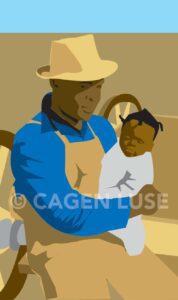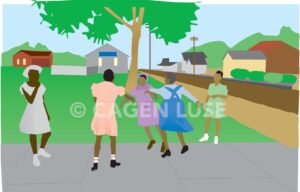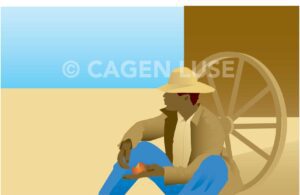Banner [Virtual] Art Gallery
James Perry in conversation with artist Cagen Luse
![Banner [Virtual] Art Gallery Banner [Virtual] Art Gallery](https://baystatebanner.com/wp-content/uploads/2024/04/Cagen-Luse_Men-at-store-e1713991226112-1024x687.jpg)
View Banner Art Gallery
Banner [Virtual] Art Gallery
Sponsored by City of Boston | Mayor Michelle Wu
This is the 18th interview in a weekly series presenting highlights of conversations between leading Black visual artists in New England. In this week’s installment, artist James Perry talks to artist Cagen Luse at the Boston Comics in Color Festival, held last Saturday at the Reggie Lewis Track and Athletic Center. The interview has been condensed and edited for clarity.
Cagen Luse is a Boston-based artist and illustrator and the creator of two comic book series: LunchTime ComiX, a biographical rendering of his family and childhood, and The Market. He is also a cofounder of Comics in Color, an organization that promotes comics by and about people of color.
James Perry: Cagen, who were you inspired by?
Cagen Luse: I grew up on comic strips. I really love comic strips. Aaron McGruder was a big influence on me. But we have Ray Billingsley here today — [creator of the] comic strip “Curtis.” He’s amazing.
And “Garfield” — that’s how I got into comics. When I was first coming up, I started out with “Garfield,” and that led me to “X-Men.” I’ve been inspired by a lot of different things. The comic strips and the artists we’ve brought here are very inspirational to me.
What are the trends among comic book artists? What do you see?
There’s been an amazing underground Black comic-book movement happening since the ’90s. Milestone Media and those guys were doing their work. Underground, there was Brotherman Comics. They were making these amazing comics. Before Black Panther was around, there were all these guys, who you’ve never heard of, making these incredible stories.
Now, there’s my show and some other shows. Black comics are really starting to come into the foreground. Some of these artists are now getting options for television shows. Robb Armstrong, who does the comic strip “Jump Start,” is now working with CBS creating a show starring Terry Crews and Tommy Davidson. Keith Knight has a television series on Hulu called “Woke.”
So, we’re finally getting recognition for the storytelling and work that Black comic artists have been doing. And I think there’s more to come. You’re hearing about how the guys from Black Mask Studios have been optioned for some shows. Ronald Wimberly, another of our special guests, is working on some television projects and stuff. It’s a real moment for Black comics and Black stories.
Tell us a little bit about your favorite series or pieces that you’ve worked on.
Before I was doing comics, I did a series called the “Americana Noir,” which was near and dear to my heart. I started doing it because my grandfather had passed away. I was feeling a certain way about the South, and Black men in the South. So, I was looking through these pictures and I saw this treasure trove of images at the Library of Congress from all over the country, that people had taken for the WPA — pictures of Black folks all over the South, in their homes.
I said, “These images are important historic images.” But I didn’t want to reproduce photographs and put them on t-shirts. So I created illustrations from them. I’ve made prints, put them on cards and [made] direct sales to people, which I love to do. I used the graphical style and did pictures of Black men in the South wearing hats, and there were very few of them, so people [would say], “That looks like my grandfather. That looks like my uncle.” I used that style so people can see themselves and their family in it. It’s a history that disappeared. It was pushed under the rug. Black folks were living lives — beautiful lives that don’t ever get talked about. There was joy. There were relationships. There was love.
We were talking earlier about the origin of Comics in Color. Tell folks a little about its origin, where you are and where you want to be.
Comics in Color all started with my friend Barrington Edwards and I meeting each other at Roxbury Open Studios — coming together because we love comics, sharing the experience of going to comic book conventions and being the only person of color there. So, from that, we went to the Black Comic Book Festival at the Schomburg in Harlem. And this room [had] hundreds of people loving comics, anime, sci-fi. It was like a paradigm flipped in our mind. We existed. There was such a thing as a Black comic book convention.
Traveling back to Boston, we said [it] needs a space like this, so we’re going to make it. This was about 2016. In 2018, when the “Black Panther” movie was coming out, it seemed like the time. Black comics were in the forefront. People were paying attention, so we said, let’s start this.
We started with 15 people meeting at Grove Hall Library and sharing comics. From there it just kind of grew. Artists came and started talking about their work. We started doing workshops. It grew and grew until we made a full-fledged festival. The first festival was supposed to be April 4, 2020. As you know, the world shut down a couple of weeks before that, but we were able to do a hybrid festival in 2021, and then this.
Where do you see this going and your work going?
As far as Comics in Color, I just see it growing and growing. I would love to expand it into different cities, take it to other cities that don’t have Black comics conventions. And as far as my work goes, I’m just going to keep making comics. I love making comics, writing stories and telling my story.
Is there anything else you would like us to know about your art?
I just love storytelling. I love hearing diverse storytellers with different perspectives. The one thing I want to say to everybody is, everybody’s story is important. Put it down on paper, draw the pictures and tell your story.
View Banner Art Gallery










